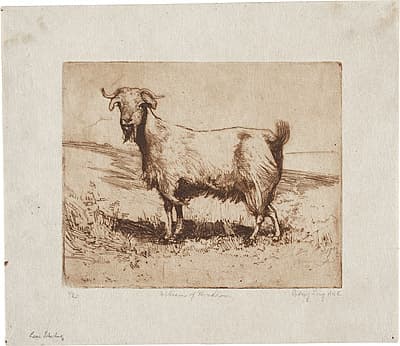
Sydney
LONG
Australia
1871
–
London
1955
England, Europe 1910-21; Australia 1921- 22; England 1922-25; Australia 1925-52; England from 1952
12.2 (h) x 15.2 (w) cm
signed ‘Sydney Long ARE’ lower right, titled lower centre and inscribed ‘7/20’ lower left below plate mark Art Gallery of New South Wales, Sydney, gift of Miss B. Kelly 1958
With horns set endearingly askew and his wisp of a tail flicked up, William of Wyndham stands firm upon his uncharacteristically fine legs. Turning his attention to the artist sketching his portrait, the stately buck poses against a picturesque backdrop of rolling paddocks rich with grass. The diagonal of the horizon is accentuated by long, fluid hatching, used to describe the fall of the slope. More energetic hatching is employed in the foreground, with sunlight and shadow, and a whisper of breeze, expressed through quick, gestural marks across the surface of the work.
Though ‘William’ was not such an unlikely name for this billy goat, the grand title, ‘William of Wyndham’, is somewhat more remarkable. It is possible he is named after the contemporaneous Sir William Wyndham, whose forebears held the Wyndham baronetcy, though he may have also taken the name of William Wyndham Grenville, who served as Prime Minister of the United Kingdom from 1806 to 1807 following the death of William Pitt the younger. Our bovid subject may not, however, have always borne such a regal title. The artist’s wife, Catherine, wrote to Aldoph Albers after Long had died: ‘I have only one etching ‘The Goat’, dry point, the best thing he ever did.’
A copy of William of Wyndham was first exhibited in 1934 at the ‘Painter–Etchers’ and Graphic Art Society of Australia exhibition’, Sydney, 3–14 December (34).
Emma Kindred
With horns set endearingly askew and his wisp of a tail flicked up, William of Wyndham stands firm upon his uncharacteristically fine legs. Turning his attention to the artist sketching his portrait, the stately buck poses against a picturesque backdrop of rolling paddocks rich with grass. The diagonal of the horizon is accentuated by long, fluid hatching, used to describe the fall of the slope. More energetic hatching is employed in the foreground, with sunlight and shadow, and a whisper of breeze, expressed through quick, gestural marks across the surface of the work.
Though ‘William’ was not such an unlikely name for this billy goat, the grand title, ‘William of Wyndham’, is somewhat more remarkable. It is possible he is named after the contemporaneous Sir William Wyndham, whose forebears held the Wyndham baronetcy, though he may have also taken the name of William Wyndham Grenville, who served as Prime Minister of the United Kingdom from 1806 to 1807 following the death of William Pitt the younger. Our bovid subject may not, however, have always borne such a regal title. The artist’s wife, Catherine, wrote to Aldoph Albers after Long had died: ‘I have only one etching ‘The Goat’, dry point, the best thing he ever did.’
A copy of William of Wyndham was first exhibited in 1934 at the ‘Painter–Etchers’ and Graphic Art Society of Australia exhibition’, Sydney, 3–14 December (34).
Emma Kindred
With horns set endearingly askew and his wisp of a tail flicked up, William of Wyndham stands firm upon his uncharacteristically fine legs. Turning his attention to the artist sketching his portrait, the stately buck poses against a picturesque backdrop of rolling paddocks rich with grass. The diagonal of the horizon is accentuated by long, fluid hatching, used to describe the fall of the slope. More energetic hatching is employed in the foreground, with sunlight and shadow, and a whisper of breeze, expressed through quick, gestural marks across the surface of the work.
Though ‘William’ was not such an unlikely name for this billy goat, the grand title, ‘William of Wyndham’, is somewhat more remarkable. It is possible he is named after the contemporaneous Sir William Wyndham, whose forebears held the Wyndham baronetcy, though he may have also taken the name of William Wyndham Grenville, who served as Prime Minister of the United Kingdom from 1806 to 1807 following the death of William Pitt the younger. Our bovid subject may not, however, have always borne such a regal title. The artist’s wife, Catherine, wrote to Aldoph Albers after Long had died: ‘I have only one etching ‘The Goat’, dry point, the best thing he ever did.’
A copy of William of Wyndham was first exhibited in 1934 at the ‘Painter–Etchers’ and Graphic Art Society of Australia exhibition’, Sydney, 3–14 December (34).
Emma Kindred
